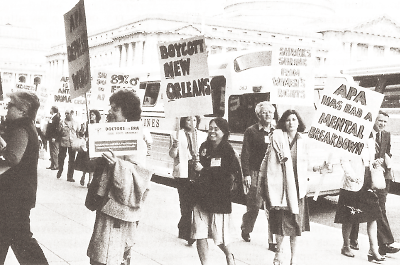In the 1970s and 1980s, APA found itself embroiled in the same controversies swirling around in the rest of American society, including the major shifts in the roles of women.
The most visible aspect within APA of that social change may have been the struggle of how best to encourage ratification of the Equal Rights Amendment (ERA), a struggle that consumed much ink in the pages of Psychiatric News.
Versions of the ERA had been proposed since 1923 but had been defeated over and over in the U.S. Congress. Its history seems a remarkable inversion of present-day politics. The Republican Party included the ERA in its platform from 1940 to 1980. New Dealers, Eleanor Roosevelt, the American Civil Liberties Union, and labor unions opposed it on the grounds that it would take away special workplace protections for women.
Led by Rep. Martha Griffiths (D-Mich.), the ERA of the 1970s was passed by the House in 1971 and the Senate in 1972. The deadline set for ratification was 1979. By 1977, 35 states had ratified the amendment, three short of the 38 needed for adoption. A legally questionable three-year extension of the ratification deadline was passed in 1978, but no additional states voted to ratify and the amendment failed.
APA went on record in 1974 and again in 1977 in support of the ERA and urged ratification. Trying to exert more pressure for ratification, APA’s Board of Trustees voted to cancel the 1981 Annual Meeting in New Orleans because Louisiana had not ratified the amendment. However, a group of members successfully petitioned the Board to hold a referendum stating that APA would “not prohibit the holding of meetings in a state which has not passed the Equal Rights Amendment.”
The statement on which members were asked to vote in the referendum appeared in the January 18, 1980, issue of Psychiatric News, and later issues published many letters arguing for and against the measure.
The referendum, wrote Elaine Hilberman, M.D., and Brenda Solomon, M.D., chair and vice chair of APA’s Committee on Women, respectively, “has the potential for creating extraordinary divisiveness in APA.”
“The divisiveness was created by those who sought to use APA to support their political interests,” countered a letter from Henry Brackin Jr., M.D., of Nashville. “No small pressure group should be a spokesman for all the members on such political issues.”
It wasn’t only politics, said former APA President Judd Marmor, M.D.
“Anyone who assumes the issue of discrimination has no mental health implications either has never experienced such discrimination or is seriously lacking in the capacity to empathically identify with those who have,” wrote Marmor.
The April 18, 1980, issue of Psychiatric News reported that 5,679 members voted not to boycott nonratifying states, with 4,461 voting to maintain the boycott.
The controversy didn’t stop with the referendum. A group called Psychiatrists for the ERA (PFERA) invited journalist Gloria Steinem to the 1980 San Francisco meeting. Steinem’s celebrity status ensured wide coverage of the issue inside and outside APA.
Boycott advocates also looked beyond ratification to point out significant disparities in psychiatry.
“About 88 percent of APA members were men, and two-thirds of our patients were women,” said Jean Shenoda Bolen, M.D., in a recent interview. (The ratio today is about 60/40, male/female among APA members.) In 1980, Bolen was the West Coast chair of Psychiatrists for the ERA. PFERA vowed to inform women contemplating psychotherapy about the likely sexist views of the male psychiatrists who were likely to treat them. They asked that more women be appointed to the APA Board and the editorial board of the American Journal of Psychiatry.
Exchanges continued in the pages of Psychiatric News about the boycott, the restricted professional opportunities for women psychiatrists, and the treatment of women patients.
The 1981 Annual Meeting was ultimately held in New Orleans, although some members chose not to attend.
“The ERA episode served a major consciousness-raising role, and that was a good thing,” Bolen said. “Sometimes you lose, but you still persevere to make a point. We raised equal rights as an issue for every psychiatrist in APA, and they had to decide if they would go to New Orleans.”
The battle of the ERA was not in vain, she said. It contributed to psychiatry by demonstrating that women were not treated as equal to men and had been kept from achieving their full potential.
Change would come, however. In 1985, Carol Nadelson, M.D., became the first woman president of APA.
“I think that every woman psychiatrist who got involved in this effort at the national level, and those who spoke about the reasons behind the boycott of New Orleans in her district branch, found her voice—after the years of training and being in hierarchal situations, where maintaining silence on issues related to sexism was a survival skill,” said Bolen. ■


